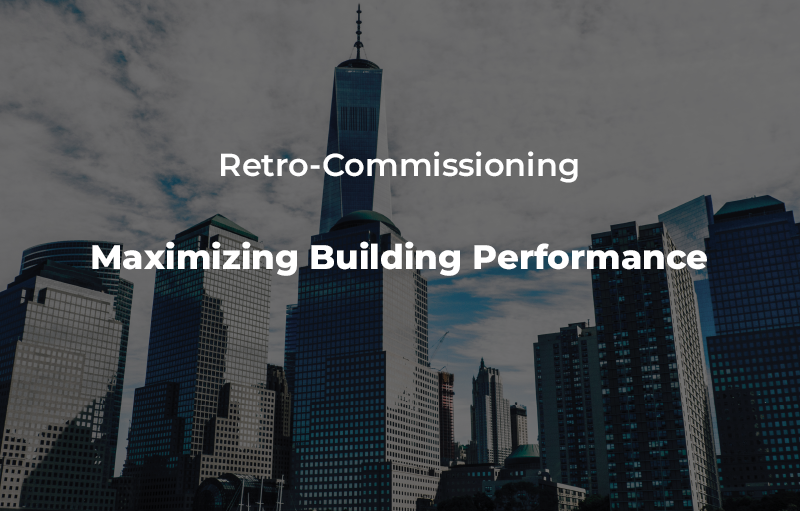
15 Mar Retro-Commissioning: Maximizing Building Performance
Properties in New York City face occupancy and operational changes that impact the functionality of energy systems. Building owners need to undertake measures to fix the issues that prevent power equipment from delivering optimal performance. The process of retro-commissioning (RCx) NYC plays a huge role in enhancing the efficiency of the existing electricity systems. Jump into this article to get more details about the process.
Understanding the Concept
We already know that the process can help in making a building more energy-efficient. But what is retro-commissioning exactly?
Properties can enjoy improved power usage and lower carbon footprint by installing advanced energy systems. But all building owners don’t have the financial capacity to implement such drastic improvements. With retro-commissioning, buildings can succeed in reducing their energy usage and operating costs without installing new upgrades.
The process is all about making the current power systems more efficient. As a result, the existing systems will be able to run longer and perform efficiently without the need for replacement.
The first part of the term “retro-commissioning” indicates that the process is meant for established or old properties. Meanwhile, the second part, “commissioning,” is all about making an establishment as power-efficient as possible.
The process is implemented while performing building upgrades to make the structure comply with energy-efficiency needs. Instead of spending on completely new systems, it will revolve around the maintenance and operation of existing ones to make them more efficient. In case an existing building was originally commissioned, a recommissioning process will offer similar benefits in enhancing the diminished performance.
The Different Phases of the Retro-Commissioning Process
This particular process for improving energy efficiency takes place in three stages. Get an overview of each phase to develop a complete understanding of the process.
Survey
The first stage is discussing the major problems of your building with a professional who can offer this service. The service provider will look at utility bills from past months to understand the performance of your property compared to similar establishments. By analyzing historical data, the professional will also be able to assess the performance of your energy systems in different weather conditions.
Next, they will focus on performing a physical assessment of your property. They will check the age and condition of the power equipment. They will also determine whether building owners maintain the systems properly and if they are performing efficiently.
These professionals usually ask the following questions while assessing your property:
- Are the equipment serving their original purpose?
- Are there any issues with their functionality?
- Have they been updated to match the changing infrastructure?
Investigation
Once the professionals realize the gaps and deficiencies, they focus on undertaking conservation measures to mitigate the issues. These initiatives can be something simple to improve the equipment or massive physical alterations to fulfill the current needs of a property.
Before recommending any particular measure, the professional will assess the amount of energy it would save and the cost of implementing it. Property owners will also get an overview of the price of hard installation at this stage. The expenditure is divided by the approximate savings to determine the ROI.
Implementation
After retro commissioning professionals gather the necessary information in the first two stages, and they generate a report for the property owner. Under the expertise of the professionals, building owners can choose the conservation initiatives to implement. The experts also offer assistance with the upgrades to confirm smooth installation and optimal performance.
A major aspect of this stage is familiarizing building occupants with the new equipment. They get the O&M manual and built documentation. When this final stage is over, the experts will create a final report to validate the installations and their efficient operation.
If the property owner has chosen an incentivized program, they can also receive assistance with documentation and paperwork. It will help them receive the final incentives from their electricity company.
Focusing on the Benefits
Depending on the property and the needs of the owner, the process can offer a plethora of advantages. A few key reasons to invest in the process of retro-commissioning include:
Cost Savings
These efforts can enable building owners to enjoy massive cost savings. If the equipment in your establishment functions efficiently, it will consume less power. As a result, your utility bills will come down. If your RCx projects are non-incentivized, your cost savings will be even higher.
Greater Temperature Control
Proper retro-commissioning measures can significantly reduce energy consumption. If your HVAC systems don’t function efficiently, they will fail to circulate heat or cold air properly. Hot or cold spots might engulf your property due to inefficient circulation. Identifying the issues and fixing them will remove these uncomfortable areas inside your building and make the tenants feel at ease.
Better Air Quality
A lack of proper ventilation and humidity control can degrade indoor air quality. Issues with air filtration can cause the same issue. RCx often involves taking proper initiatives to enhance the performance of HVAC systems. It helps in improving the purity of air inside a property and reduces respiratory issues for the residents.
Improve Lighting
Retro commissioning measures also focus on improving the lighting inside a property. It makes an establishment safer. A lack of proper lights can cause accidents and hinder productivity. RCx can get rid of dim areas in your building to navigate around smoothly.
Increase the Longevity of Equipment
Inefficient operation can cause the energy equipment of your establishments to have a shorter lifespan. Maybe the HVAC system of your building operates without operation or undergoes component reversal to maintain a particular temperature. If that’s the case, it will definitely wear out faster than an HVAC system that offers stable operation at a lower capacity.
If the systems wear out faster, you will have to replace them sooner and bear high expenses. With retro commissioning initiatives, property managers can extract maximum value out of their power equipment. No premature replacement of components or whole systems will make them more efficient.
How Can The Cotocon Group Help?
At The Cotocon Group, we have a team of retro-commissioning professionals to improve the energy performance of existing building systems. We will perform a detailed energy audit to identify areas of improvement and provide a report with smart recommendations. You can trust our services to lower the carbon footprint of your property and promote environmental sustainability.
Final Words
The purpose of RCx is to make the energy equipment in your property offer maximum value without the need for premature repair or replacement. It helps in maximizing your energy efficiency while providing financial benefits. If you need to hire retro-commissioning experts for your NYC building, The Cotocon Group should be your ultimate destination. Get in touch today to consistently improve the power consumption of your establishment throughout its lifetime.
FAQs:
What is the cost of RCx services in New York City?
The cost of hiring RCx services will differ according to the size and age of your property. The condition of the existing power equipment in your building will also influence the cost. But it is a worthwhile investment because undertaking the measures recommended by retro-commissioning experts reduce utility bills and carbon footprint.
Is any financial aid available for retro-commissioning?
Some utility providers offer financial aid to buildings focusing on retro-commissioning. Since these fully-funded programs are often underutilized, you should check whether your facility is eligible for them.
What is the difference between retro-commissioning and recommissioning?
The first process is about improving the existing energy systems of an old building to meet current requirements. If the same building was commissioned previously, the recommissioning process helps support the improvement of existing power equipment and adjusts it according to current needs.
